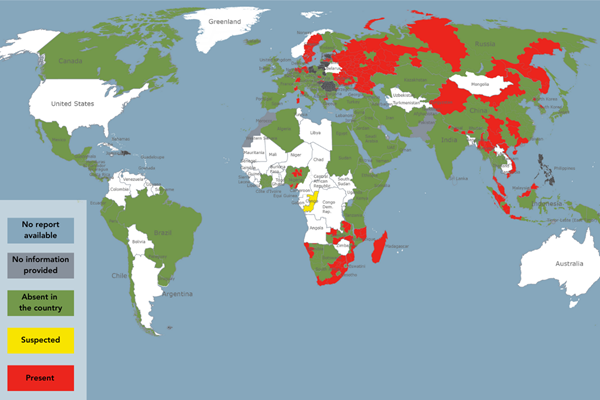Stalosan F – a powerful farm biosecurity tool, capable of killing ASF and FMD viruses
A new efficacy test from Vietnam, distributed by our partner San Group, reveals a piece of break-through information about the Stalosan F efficacy against a variety of disease-causing microorganisms, including the FMD and ASF viruses.
Foot and mouth disease (FMD) is considered one of the most important diseases of cloven-hoofed animals, affecting cattle, buffaloes, pigs, sheep, goats, and about 70 wildlife species. The disease is estimated to circulate in 77% of the global livestock population in Africa, the Middle East and Asia, as well as in a limited area of South America. Although FMD is a disease of low mortality, the global impact is colossal due to the huge numbers of animals affected. It spreads quickly and causes significant economic losses, due to reduced production and losses caused by costs of FMD control and limited access to markets. The annual global economic impact of FMD has recently been estimated at USD 11 billion in endemic areas and an additional minimum of USD 1.5 billion was ascribed to virus incursions into FMD-free countries. (Knight-Jones and Rushton, 2013).

Another important pathogen, responsible for massive losses in pig populations and drastic economic consequences, African swine fever (ASF) has become a major crisis for the pork industry in recent years. With no effective vaccine, the disease is not only impeding animal health and welfare but has also detrimental impacts on biodiversity and the livelihoods of farmers.
In total, since January 2020, ASF has been reported as present in five different world regions in 39 countries, affecting more than 1,125,000 pigs and more than 36,000 wild boars (data reported through INs and FURs), with more than 1,960,000 animal losses.

Figure 2: Map of the world displaying the presence of ASF by Administrative divisions. (2021 –27/04/2023)
Source: WOAH
“The results showed that at an exposure time of 10 minutes or 30 minutes, the disinfectant showed a very high ability to inactivate the bacteria and viruses used in the test. Thus, at the moment after spraying, the disinfectant has a completely inactivating effect on the types of bacteria Escherichia coli, Salmonella sp., Staphylococcus sp. and Streptococcus sp. as well as the disease-causing viruses Foot and mouth disease, Blue Ear (PRRSV), African swine fever and the highly virulent avian influenza (HPAIV H5N1). In other words, in this experiment, the minimum time it takes to inactivate the pathogen was 10 minutes.”
Having in hand a powerful tool like Stalosan F, capable of killing ASF and FMD viruses, can make the difference in the global fight with notable diseases, if applied as a part of strict biosecurity procedures.
Find out more about Stalosan F.
For more information, please contact Plamen Nikolov: +45 3154 6406

